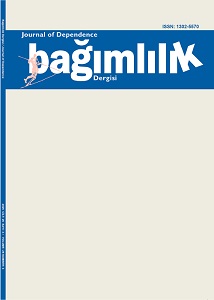THE ROYAL ROAD TO THE OBESİTY: A CASE REPORT OF FOOD ADDİCTİON
Keywords:
Addiction, attention deficit hyperactivity disorder, obesityAbstract
Increasing prevalence of obesity in the world and increasing role of processed foods in daily life has led to become the focus of the food addiction. In recent years, the animal studies and human brain imaging studies demonstrated the neurobiological and behavioral similarities between drug addiction and food addiction. Here, we aim to present a 13 year-old, female, 7th grade student who applied with complaints of anger and irritability and shows serious addictive behaviors of chocolate. Our patient with increasing chocolate consumption in the last two years was using atomoxetine 60 mg/day with ADHD. She gradually needs to more chocolate to be satisfied. She has complained of nervousness, irritability and serious chocolate-seeking behavior during chocolate deprivation. She gained weight in proportion to the increase in chocolate consumption. Her daily diet was increasingly deteriorated. We used behavioral approach and sertraline in her treatment and were observed that partially benefit from treatment. Combined data from retrospective accounts of adults and prospective observations of youth indicates that juveniles with ADHD are at increased risk for cigarette smoking and substance abuse and behavioral addiction such as internet addiction, gambling and sex addiction during adolescence. Recognition of the food addiction is important to fight against obesity, strengthening the treatment of choice in the food addiction and take political preventions against food addiction are becoming inevitable.
References
Gearhardt AN, Davis C, Kuschner R et al. The addiction potential of hyperpalatable foods. Curr Drug Abuse Rev 2011; 4: 140-145.
Cocores JA, Gold MS. The salted food addiction hypothesis may explain overeating and the obesity epidemic. Med Hypotheses 2009;73:892-899.
Oyekcin DG, Deveci A. Etiology of food addiction. Current Approaches in Psychiatry 2012; 4: 138-153.
Carter A, Hendrikse J, Lee N et al. The neurobiology of “Food addiction” and its implications for obesity treatment and policy. Annu Rev Nutr 2016; 36: 105-128.
Schulte EM, Avena NM, Gearhardt AN. Which foods may be addictive? The roles of processing, fat content, and glycemic load. PLoS One 2015; 10: e0117959.
Weiner B, White W. The Journal of Inebriety (1876-1914): History, topical analysis, and photographic images. Addiction 2007; 102: 15-23.
Bruinsma K, Taren DL. Chocolate: Food or drug? J Am Diet Assoc 1999; 99: 1249-1256.
Hetherington MM, MacDiarmid JI. “Chocolate addiction”: A preliminary study of its description and its relationship to problem eating. Appetite 1993; 21: 233-246.
Volkow ND, Wang GJ, Fowler JS et al. Overlapping neuronal circuits in addiction and obesity: Evidence of systems pathology. Philos Trans R Soc Lond B Biol Sci 2008; 363: 3191-3200.
Johnson PM, Kenny PJ. Dopamine D2 receptors in addiction-like reward dysfunction and compulsive eating in obese rats. Nat Neurosci 2010; 13: 635-641.
Spencer TJ, Biederman J, Mick E. Atten-tion-deficit/hyperactivity disorder: Diagnosis, lifespan, comorbidities, and neurobiology. J Pediatr Psychol 2007; 32: 631-642.
Weinstein A, Yaacov Y, Manning M, et al. Internet addiction and attention deficit hyperactivity disorder among school children. Isr Med Assoc J 2015; 17: 731-734.
Borengasser SJ, Kang P, Faske J ve ark. High fat diet and in utero exposure to maternal obesity disrupts circadian rhythm and leads to metabolic programming of liver in rat offspring. PLoS One 2014; 9: e84209.
Downloads
Published
How to Cite
Issue
Section
License
Copyright (c) 2025 Journal of Dependence

This work is licensed under a Creative Commons Attribution-NonCommercial-NoDerivatives 4.0 International License.
...
